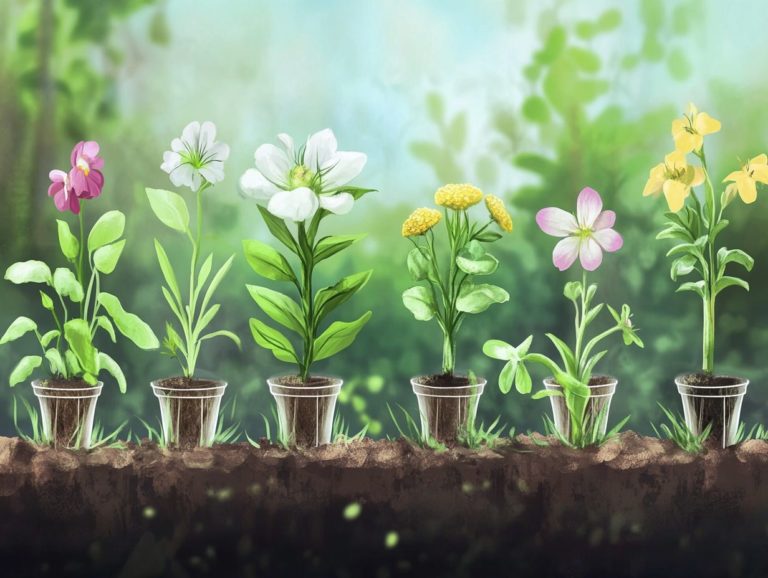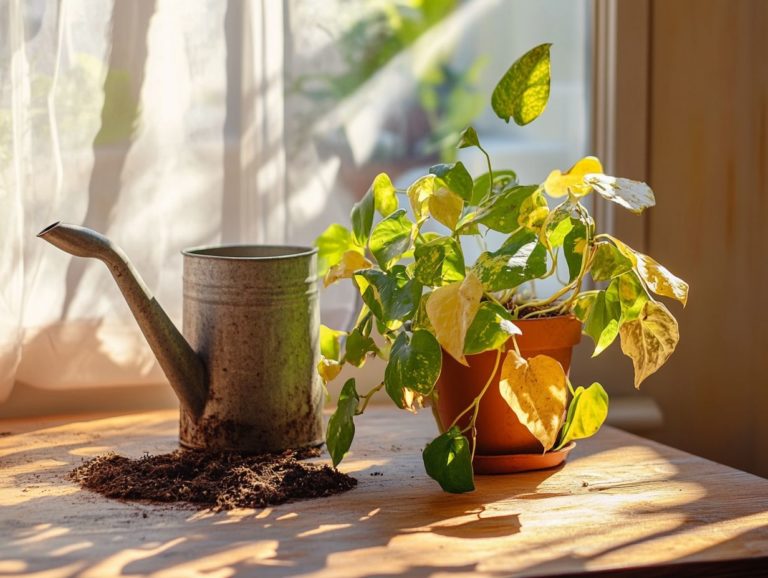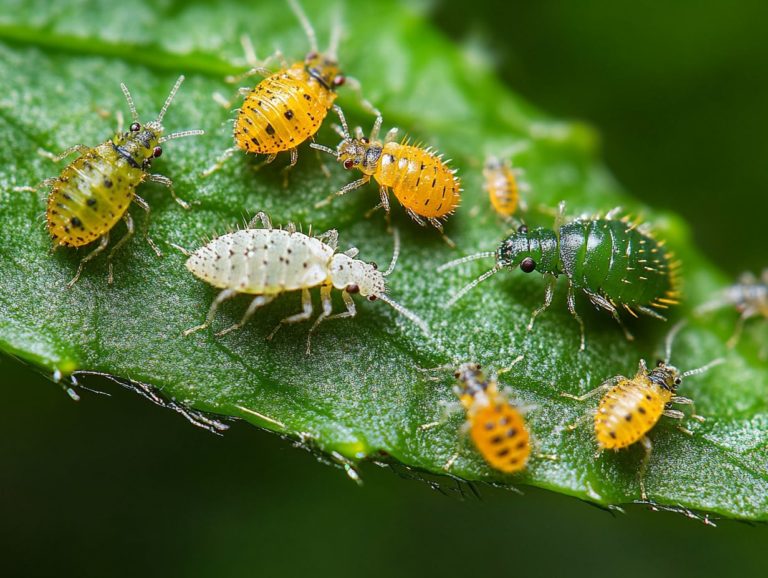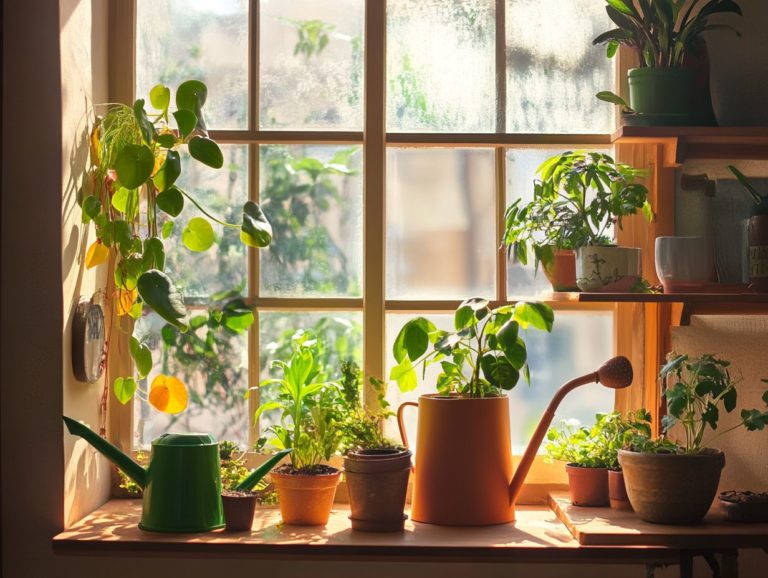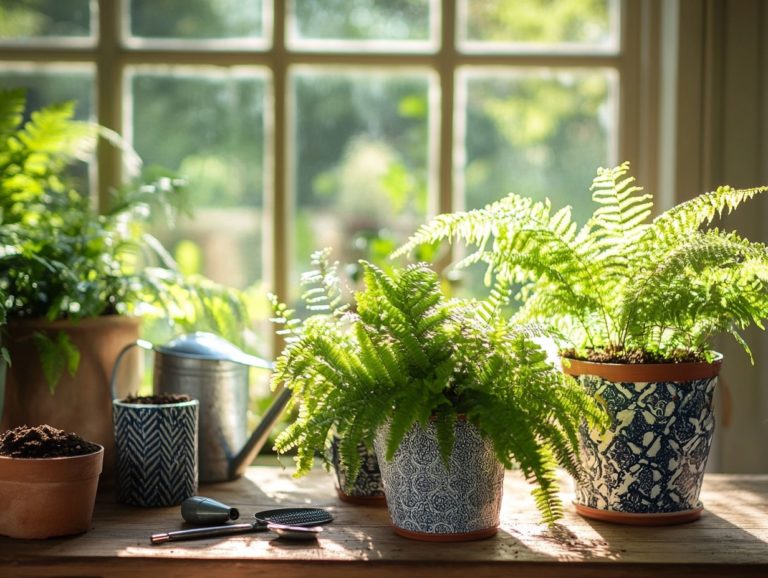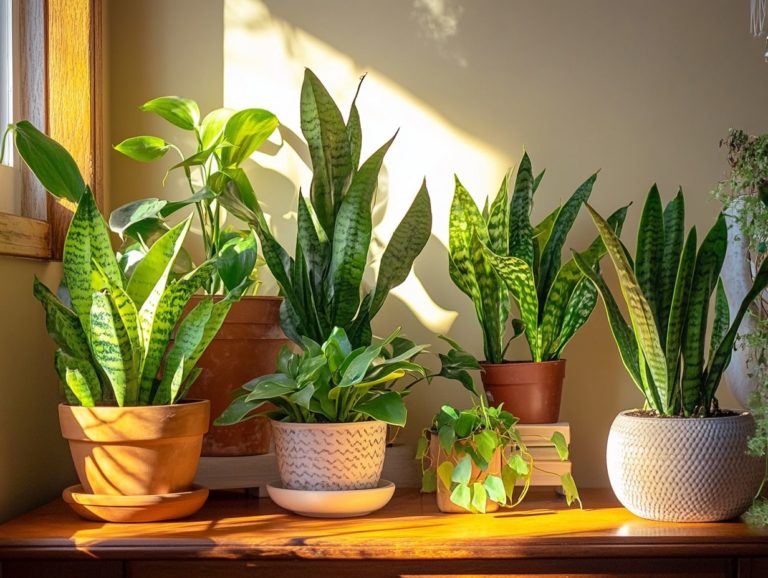What are the Most Popular Indoor Plant Varieties?
Indoor plants and houseplants have transformed into essential elements for enriching your living spaces, providing numerous benefits, from enhancing air quality to elevating your mood and sparking creativity.
With a plethora of options at your fingertips, selecting the right plants for your home can feel daunting.
This guide will distill the key factors you should consider when choosing indoor plants, introduce you to ten popular varieties, and offer invaluable maintenance tips for their proper care.
Whether you re just starting your plant journey or you re a seasoned plant parent, this resource has something tailored for you.
Contents
- Key Takeaways:
- Benefits of Having Indoor Plants
- Factors to Consider When Choosing Indoor Plants
- 10 Most Popular Indoor Plant Varieties
- Tips for Caring for Indoor Plants
- Frequently Asked Questions
- What are the Most Popular Indoor Plant Varieties?
- What makes spider plants a popular indoor plant variety?
- Why are succulents a top choice for indoor plants?
- What makes peace lilies a popular indoor plant choice?
- Why are pothos plants a favorite among indoor gardeners?
- What makes snake plants a must-have indoor plant variety?
- Why are Chinese evergreens a top indoor plant choice for many people?
- Want Your Indoor Plants to Thrive? Proper Watering and Fertilization is Key!
- Dealing with Common Pests and Diseases
Key Takeaways:

- Spider Plant, Pothos, and Snake Plant are some of the most popular houseplants due to their low maintenance and air-purifying qualities. Don t miss out on these amazing plants!
- When choosing indoor plants, consider their light and water requirements, as well as size and maintenance needs, to ensure they thrive in your home.
- Proper watering and fertilization, as well as dealing with common pests and diseases, are essential tips for caring for indoor plants and ensuring their longevity.
Benefits of Having Indoor Plants
Having indoor plants brings many benefits that improve both the look and feel of your home. With their air-purifying abilities, they enhance indoor air quality while also adding a touch of beauty and tranquility to any room.
Houseplants aren’t just for decoration; they can uplift your mood, reduce stress, and introduce vibrant colors and textures into your daily life. Certain species, especially tropical plants native to humid conditions, flourish in indoor environments, making them a fantastic choice for your home.
Looking for plants that are low-maintenance? Resilient houseplants are your best friends! Favorites like the Snake Plant and Peace Lily look stunning and are also easy to care for, making them ideal companions for your busy lifestyle. If you’re curious about what is the best indoor plant for beginners, these options are definitely worth considering!
Factors to Consider When Choosing Indoor Plants
Choosing the right indoor plants requires careful consideration of several crucial factors that will ensure healthy growth and compatibility with your living space. Begin by assessing the specific light and moisture conditions in your home, as different plants have unique needs; for example, tropical plants tend to thrive in humid conditions, while succulents plants that store water in their leaves flourish in dry, well-drained soil.
It’s important to learn each plant’s watering schedule and maintenance needs, which will guide you in selecting low-maintenance options that seamlessly integrate into your lifestyle. By providing proper care, including a consistent watering schedule, you’ll not only keep your indoor greenery flourishing but also elevate the decorative appeal of your home.
Light and Water Requirements
Understanding the light and watering needs of your indoor plants is essential for their health and longevity. Each houseplant comes with its own set of preferences; for example, tropical plants typically thrive in bright, indirect light, while succulents can bask happily in low light.
Consider how factors like the time of year and the specific location within your home can dramatically influence the light available to your plants. A south-facing window may be the perfect spot for those sun-loving varieties, while northeastern exposures could be just right for common houseplants that prefer shade.
Equally important is maintaining a consistent watering schedule. Keeping an eye on soil moisture levels whether by using moisture meters or simply checking with your finger will guide you on when to give your plants a drink. This level of attentiveness not only ensures your plants receive the right amount of moisture but also helps avoid the pitfalls of overwatering, creating a flourishing indoor ecosystem.
Start your indoor garden today and enjoy all the benefits these beautiful plants bring!
Size and Maintenance
When selecting indoor plants, it s crucial to consider their size and maintenance requirements to create a harmonious living environment. Some plants, like Fiddle Leaf Figs, can grow tall and flaunt large leaves, becoming stunning focal points in your room. Others stay compact and manageable, making them perfect for smaller spaces.
If you lead a busy lifestyle, exploring low-maintenance plants allows you to enjoy greenery without the stress of extensive care. By understanding growth patterns and common varieties, you can choose plants that seamlessly fit into your living space and desired aesthetic.
Placement is equally important. Larger varieties need more floor space and should be positioned away from high-traffic areas to avoid damage. In contrast, smaller plants can find their home on shelves or window sills, bringing life to those often-overlooked spots.
For instance, succulents and pothos are excellent choices for novices. They thrive with minimal attention, while larger options like rubber trees or indoor trees can elevate a room’s appearance but may require more light and moisture.
By thoughtfully selecting both the size and type of indoor plants, you can create a vibrant yet balanced atmosphere that beautifully complements your home.
10 Most Popular Indoor Plant Varieties
In indoor gardening, certain varieties truly shine for their popularity, ease of care, and decorative impact. These beloved houseplants enhance the beauty of your space and improve your indoor environment by helping to purify the air.
Take the Snake Plant and Fiddle Leaf Fig; both are celebrated for their striking appearance and lush, attractive foliage, making them a top choice for plant lovers. If you’re curious about the most resilient indoor plants, whether you prefer tropical fronds or hardy houseplants that are easy to care for, this curated list presents a diverse array of options tailored to your unique tastes.
1. Spider Plant
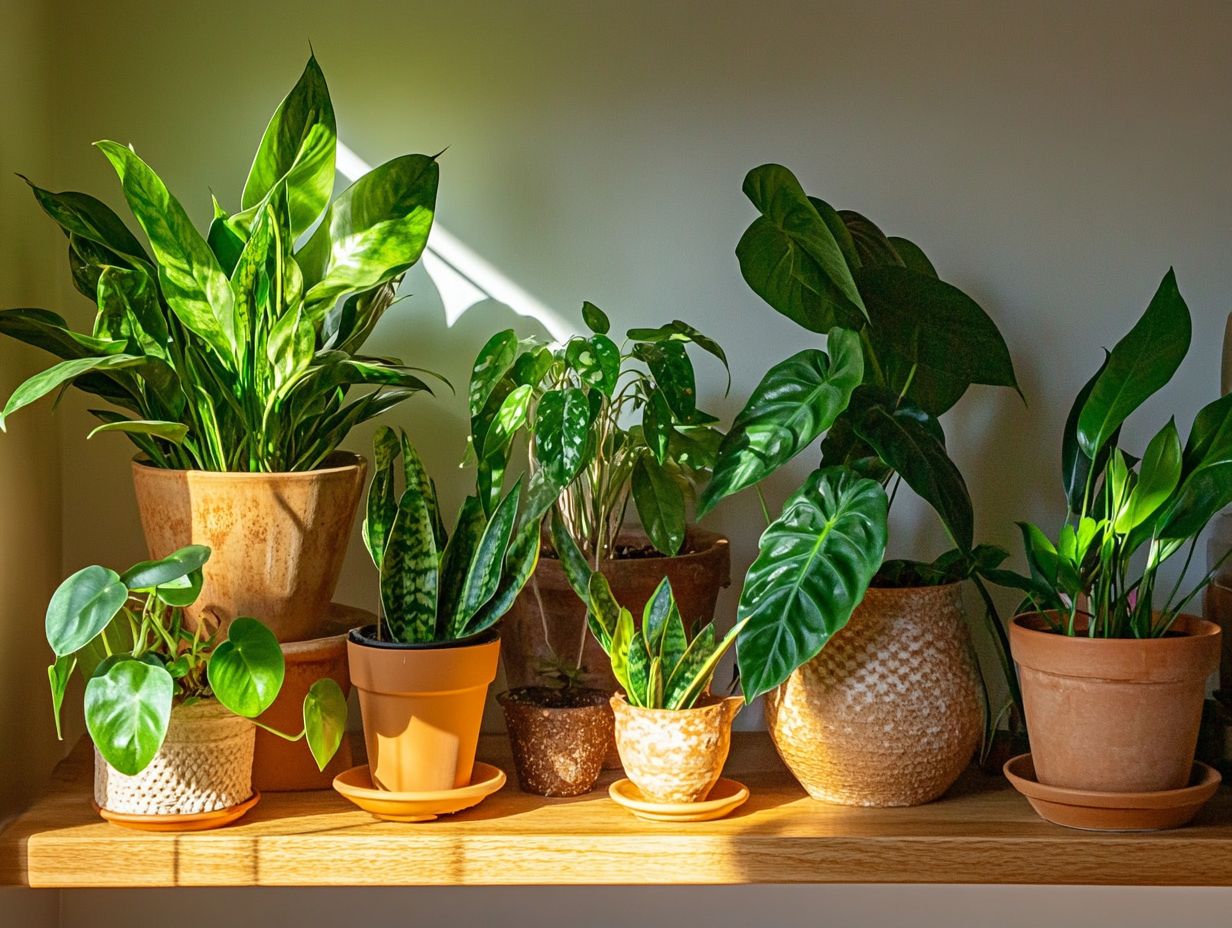
Discover the beauty and ease of the Spider Plant! This plant is a favorite among indoor gardening fans, thanks to its vibrant glossy and attractive foliage and effortless care requirements. Its remarkable resilience allows it to flourish in various light conditions, making it a versatile addition to your home d cor. It beautifies your space while also purifying the air and promoting a healthier living environment. With its unique look characterized by arching leaves and charming little white flowers it offers both functionality and visual appeal.
For optimal growth, the Spider Plant thrives in bright, indirect light but can adapt to lower lighting situations. Water it when the top inch of soil feels dry, as overwatering can lead to root rot (when roots decay due to excess water) a fate best avoided. Propagation (growing new plants from existing ones) is easy; this plant often produces ‘pups’ that you can effortlessly replant in soil or water.
Keep an eye out for common challenges, such as browning leaf tips, which may signal low humidity or improper watering, especially for tropical plants that love humidity. Regular checks for pests like spider mites or aphids can help ensure your Spider Plant remains in peak health.
Which plant will you choose to elevate your space? Don’t miss out on adding this beautiful plant to your home today!
2. Pothos
Pothos is the ultimate plant choice for everyone! It’s known for low maintenance and stunning trailing vines, making it ideal for beginners and seasoned gardeners alike.
This resilient houseplant adapts to various lighting, from bright indirect light to low light. It thrives in almost any environment you provide.
Pothos also acts as an excellent air purifier, effectively removing toxins from your indoor air. This contributes to a healthier living space.
Its attractive heart-shaped leaves add a decorative touch that enhances any interior.
To keep your Pothos thriving, water it when the top inch of the soil feels dry, typically every one to two weeks. Be careful not to overwater, as this can lead to root rot; good drainage is vital.
Pothos prefers indirect sunlight but can tolerate fluorescent lighting, making it a great choice for offices or dim rooms. Propagation is easy: simply cut a few inches of stem below a node, place it in water or soil, and watch as it grows roots. You can enjoy even more beautiful vines or share them with friends!
3. Snake Plant
The Snake Plant stands out with its striking upright leaves. It’s one of the most popular houseplants due to its remarkable drought tolerance.
This resilient beauty requires minimal maintenance, making it a favorite among busy people and plant care newcomers. With common varieties available, it’s easy to find one to match your style.
This plant thrives in low light and indirect sunlight while also excelling at air purification, enhancing indoor air quality. Its sleek modern look adds elegance to any room.
Water your Snake Plant sparingly, allowing the soil to dry out completely between waterings to avoid root rot. Bright, indirect light will encourage vigorous growth.
Regularly check for pests and keep its leaves dust-free to maintain its beauty. This ensures it remains a stunning focal point in your home for years!
4. Peace Lily
The Peace Lily is a remarkable flowering houseplant, famous for its elegant white blooms and impressive air-purifying abilities. It flourishes in indirect light and even low-light conditions, making it perfect for darker rooms.
However, be cautious Peace Lilies are toxic to pets. If you have furry companions, exercise care.
With proper care, the Peace Lily not only beautifies your indoor space but also cleans the air around you. Keep the soil consistently moist but not soggy, allowing the top inch to dry out between waterings for vibrant foliage.
Peace Lilies filter out common indoor pollutants, contributing to a healthier environment. If you’re a pet owner, remain vigilant, as ingestion can cause digestive discomfort for your cats and dogs.
With mindful attention, your Peace Lily can thrive, enriching your home with beauty and freshness!
5. Rubber Plant
The Rubber Plant is truly a gem in indoor gardening, celebrated for its large, glossy leaves and impressive growth. It’s a favorite in many homes because it grows easily in bright indirect light and can also adapt to low light.
Its low-maintenance nature allows you to enjoy its striking appearance without much fuss. It also purifies the air, making your space healthier.
Water your Rubber Plant when the top inch of soil is dry, typically every week or two. Be cautious; overwatering can lead to root rot, so ensure you use a pot with good drainage. Don’t wait too long between waterings; your plants will thank you for it!
Regularly dusting those impressive leaves not only enhances their beauty but also boosts their air-purifying efficiency.
Fertilizing monthly during the growing season will encourage lush growth, filling your indoor space with vibrant life and energy.
6. Aloe Vera
Aloe Vera is a striking houseplant that captivates with its unique appearance. This plant doesn t need much water and offers soothing gel renowned for various wellness applications.
It grows easily in bright sunlight while also adapting to indirect light, making it a versatile choice for your indoor garden. Its low-maintenance nature is a boon for busy lifestyles.
Water it when the top inch of soil feels dry, typically every three weeks, depending on the season. Its thick, fleshy leaves store moisture, allowing it to withstand periods of neglect, perfect for anyone juggling a hectic schedule.
Beyond its aesthetic appeal, Aloe Vera’s gel is revered for its hydrating and healing abilities, making it a go-to for soothing sunburns. By inviting this remarkable plant into your space, you enhance your d cor and gain access to a natural remedy for skincare needs.
7. Philodendron
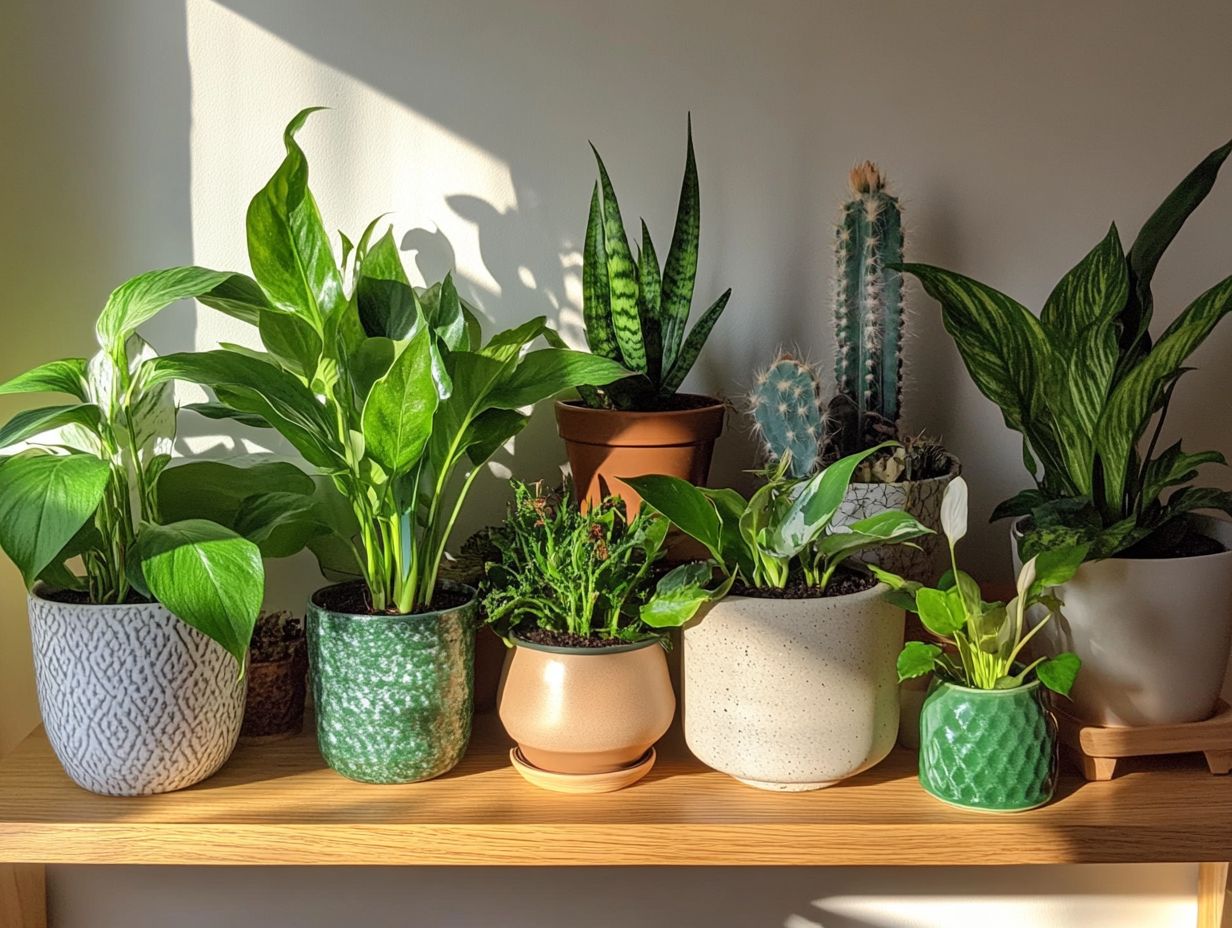
Philodendron plants are a gem for any indoor space, known for their trailing vines and lush foliage. They grow easily in low light and adapt gracefully to varying care levels. These plants also purify the air, enhancing your indoor air quality.
Among the various types, the heartleaf Philodendron stands out with its stunning, glossy leaves that cascade beautifully. The robust ‘Birkin’ delights with its striking white variegation against dark green leaves.
Care requirements can vary slightly. The heartleaf prefers moderate watering, while the ‘Birkin’ thrives with slightly drier soil between waterings. Both enjoy bright, indirect light but are tolerant of lower light conditions.
With their adaptable nature and remarkable ability to purify the air, Philodendrons are not just a feast for the eyes; they re an invaluable asset for creating a healthier living environment.
8. English Ivy
Known for its classic beauty, English Ivy stands out as a popular houseplant. It boasts trailing vines and decorative foliage that effortlessly elevate your space. This plant cleans the air and thrives in bright, indirect light. It can also survive in lower light.
Versatile as it is, English Ivy can grace your home in hanging baskets or climb elegantly, adding a distinctive touch to your interior decor.
With just a bit of attention to its watering needs keeping the soil moist but never soggy you ll find this plant flourishing beautifully. Opt for a well-draining potting mix that allows excess water to escape while retaining essential moisture.
As a bonus, English Ivy actively filters toxins from the air, making it an excellent addition to your bedrooms or living areas. Style it in myriad ways, whether cascading over shelves or trailing gracefully from window sills. This transforms it into both a decorative and practical choice for enhancing your home environment.
9. Chinese Evergreen
Chinese Evergreen is your go-to resilient houseplant. It’s celebrated for its stunning foliage and remarkable ability to thrive in low light and humid conditions. This plant is super easy to care for! It adapts effortlessly to various environments, making it an excellent choice for those venturing into indoor gardening.
It flourishes in indirect sunlight and fits perfectly in corners or areas where natural light is scarce. Ideally, it thrives at temperatures between 60-75 F. Maintaining a humidity level of around 50% can boost its growth. Consider misting or placing it in moisture-rich spaces like bathrooms or kitchens.
Beyond its adaptability, this enchanting plant showcases leaves with different colors hues of green, silver, and hints of red, making it a striking focal point in any room. If you’re interested in adding such plants to your space, be sure to know what to look for when buying indoor plants. Its air-cleaning abilities help filter out harmful pollutants, adding even more value to its presence in your indoor oasis.
10. ZZ Plant
The ZZ Plant stands out as a premier choice for indoor gardening, thanks to its striking, waxy leaves and impressive drought tolerance. This resilient houseplant flourishes in low-light conditions and requires minimal upkeep perfect for those who might occasionally forget to water it. Its elegant foliage enhances any space while improving indoor air quality.
To keep your plant in tip-top shape, adhere to a few straightforward care tips:
- Water it sparingly, allowing the soil to dry out completely between waterings typically once every two to three weeks will do the trick.
- Remember, too much water can lead to root rot, so it’s wise to err on the side of caution.
Regarding light, the ZZ Plant thrives best in indirect sunlight, although it can comfortably tolerate lower light levels. This versatility guarantees it not only survives but flourishes, seamlessly fitting into both bright and dimly lit environments.
Tips for Caring for Indoor Plants
Caring for indoor plants requires a few essential tips and tricks that can truly elevate their growth and longevity. Establishing a consistent watering schedule is key. This ensures your plants receive just the right amount of hydration without the pitfalls of overwatering or underwatering.
Regularly inspecting for common pests and diseases is vital for maintaining their health. This enables you to intervene promptly when issues arise. By providing care that caters to the specific needs of each plant such as light requirements and soil conditions you can cultivate a flourishing indoor garden that thrives beautifully.
Transform your home environment with these plants today! Their charm and benefits are too good to miss.
Frequently Asked Questions
What are the Most Popular Indoor Plant Varieties?
Some of the most popular indoor plant varieties include spider plants, succulents, peace lilies, pothos, snake plants, and Chinese evergreens.
What makes spider plants a popular indoor plant variety?
Spider plants are popular because they are low-maintenance, easy to propagate, and help improve air quality by removing toxins from the air.
Why are succulents a top choice for indoor plants?
Succulents are popular because they require minimal watering and care, come in a variety of shapes and sizes, and add a unique aesthetic to any room.
What makes peace lilies a popular indoor plant choice?
Peace lilies are popular because they are known for their air-purifying abilities, are easy to care for, and produce beautiful white flowers.
Why are pothos plants a favorite among indoor gardeners?
Pothos plants are popular because they are low-maintenance and can thrive in low-light conditions, making them perfect for beginners or those with limited natural light in their homes.
What makes snake plants a must-have indoor plant variety?
Snake plants are popular because they are extremely resilient and can survive in a variety of conditions, including low light and neglectful watering.
Why are Chinese evergreens a top indoor plant choice for many people?
Chinese evergreens are popular because they are easy to care for, produce beautiful foliage, and are known for their ability to purify the air in your home.
Want Your Indoor Plants to Thrive? Proper Watering and Fertilization is Key!
Establishing a proper watering and fertilization routine is essential for the health of your indoor plants. Understanding the specific watering needs of different species whether they thrive in wet soil or prefer dry soil that lets water flow through easily can help you prevent common issues like root rot.
Fertilization is equally crucial, providing the essential nutrients that support healthy growth, especially during the growing season. By developing a consistent watering schedule and incorporating the right fertilizer, you can ensure your plants receive the care they need to flourish!
When crafting an effective watering schedule, consider factors such as the plant’s light exposure, humidity levels, and pot size. These elements significantly influence how quickly the soil dries out. It s important to select the appropriate type of fertilizer. Whether you choose slow-release granules or liquid formulas, timing is key. Applying fertilizers during the active growing months typically spring and summer will give your plants the boost they need.
Regularly assessing both your watering and fertilization practices can lead to a remarkable transformation. This will result in lush, vibrant greenery that enhances your living space beautifully!
Dealing with Common Pests and Diseases

Dealing with common pests and diseases is crucial for maintaining a vibrant indoor garden. This allows you to prevent significant damage to your beloved plants!
Incorporating regular routines like weekly inspections and maintaining cleanliness around your plants makes it much easier to spot potential issues before they have a chance to escalate. Utilize natural pest control methods, such as introducing beneficial insects or applying neem oil, a natural insect repellent made from the neem tree. These methods can be remarkably effective in keeping your garden thriving.
Ensure your indoor plants are in well-draining soil and avoid overwatering to prevent pesky conditions like root rot. Keep your indoor environment free from excess humidity and stagnant air to minimize the risk of fungal diseases, safeguarding the health of your flourishing green companions.

